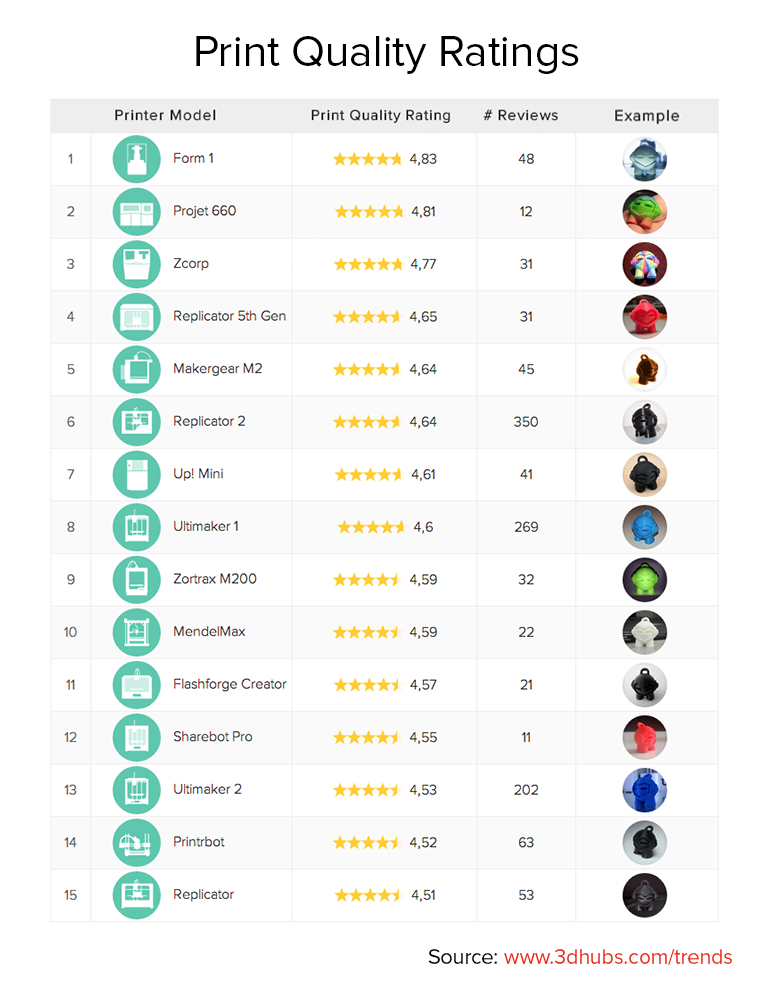3D printer network 3D Hubs has unveilled the latest information on the ratings that printer owners — from their broad and increasingly popular network — have given their devices for print output. The quality ratings provide an insight into user satisfaction by a range of 3D printer owners regarding the actual output of their printers. Using a simple five star rating system, the data has been compiled into a league table of ratings for quality of 3D prints. There are a number of 3D printers which many would anticipate to score highly, and a few suprises.
3D Hubs has continued to expand it’s network to encompass 3D printers across the globe, providing an ecosystem for printer owners to connect with those seeking 3D prints but who do not own a printer. The company releases regular monthly insights into the data that their sizable network has provided. As the network grows (5000+ and counting), the insights become an ever more accurate reflection of the world of desktop 3D printing – from geographical distribution of brands of 3D printers to the materials that are being used by printer owners.
Looking at the fifteen 3D printers that rate the highest for their print output, the mid-range and professional level printers that top the table are perhaps unsuprising. A few brands feature more than one printer in this list of but a slight slice of the huge range of desktop 3D printers that are now available. There are now literally hundreds of desktop 3D printers on the market, in a niche that has rapidly expanded over the past few years. So, to witness a few brands making the quality chart with more than one printer is a particularly notable acheivement.
MakerBot enter the chart an impressive three times, with the original Replicator Desktop 3D Printer at number 15. The printer garners an average of a 4.51 rating, hinting at the high level of customer satisfaction with all of the printers that have made the chart. The desktop 3D printer industry leader also manages to chart at number 6 with their MakerBot Replicator 2, as well as number 4 with the latest iteration of it’s MakerBot Replicator series, the fifth generation model.
Ultimaker also break into the chart with more than one 3D printer. The Ultimaker 1 residing at number 8, and the Ultimaker 2 at number 13. Notably the Ultimaker 3D printers have both been rated by the second and third highest numbers of users, 269, and 202 respectively. The highly popular MakerBot Replicator 2 gains the highest number of user ratings at some 350. The number of ratings here can be compared with the much lower number of ratings received by some of the other 3D printers, such as the ShareBot Pro at number 12 in the chart, which received it’s impressive 4.55 print quality rating from the lowest number of raters at 11. Needless to say, lower sales of some printers have resulted in their being less users to rate them; although there is still considerable kudos in achieving the high quality ratings that any printer that has made the chart have received.
Generally the printers seen at the higher end of this top quality chart are more expensive to purchase than the ones that have not quite made the upper echelons. The printrbot selection of printers – which appears generically at number 14 – is almost all within a sub-$600 price range. This contrasts highly with the table topping FormLabs Form 1 which retails at four times the price. Output print quality is in some ways subjective, particularly when comparing one 3D printing technology with another, but generally the more a person pays the higher the output print quality they would expect. To see some lower cost 3D printers make the top 15 table is perhaps quite unexpected.
The Projet 660 and Zcorp printers that make numbers 2 and 3 in the chart respectively are professional grade printers. In some ways this reflects highly on the chart topping Form 1, which many would anticipate to see lower down such a chart. That there are professional grade 3D printers in the chart alongside cheap DIY desktop printer kits does cast some questions upon the relability of the use of a mode of statistical comparison for such very different products by way of direct comparison.
What is almost certainly useful however is a simple but useful insight into how users rate their own printer. Also a means of comparison of user ratings of output print quality for the models which are directly comparible, such as the MakerBot, Ultimaker, Up! Mini, Zortrax, ShareBot Pro, and FlashForge Creator. The 3D Hubs chart places these brands up at the very top of desktop 3D printing. Alongside the comparitive 3D printer ratings websites, such as Thre3d, B3dge and Fabster, these 3D Hubs charts will continue to provide potential purchasers product insights before they pay for a printer.



